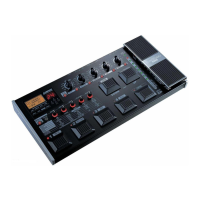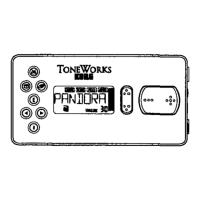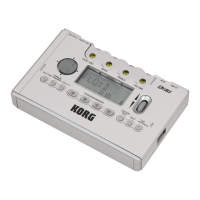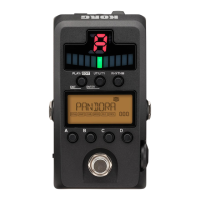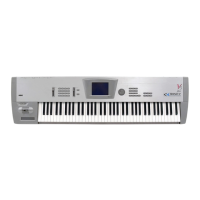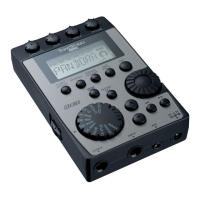
Do you have a question about the Korg ToneWorks Pandora PX4D and is the answer not in the manual?
| Brand | Korg |
|---|---|
| Model | ToneWorks Pandora PX4D |
| Category | Recording Equipment |
| Language | English |
Guidelines for placing the unit to prevent malfunctions, considering sunlight, temperature, humidity, dust, vibration, and magnetic fields.
Instructions on connecting the correct AC adapter and avoiding voltage mismatches, plus advice on preventing interference.
Instructions on handling the unit to avoid breakage and cleaning the exterior with a dry cloth.
Warnings against placing liquids near the unit and precautions for preventing electrical shock or damage from foreign objects.
Explanation of CE mark conformance to EMC and Low Voltage Directives for products sold in Europe.
Warning regarding FCC regulations for Class B digital devices and potential radio interference, with mitigation measures.
Details the unit's capacity for 100 user and 100 preset programs and highlights the backlit LCD screen.
Describes the 25 amp types, REMS technology, and the Auto Tuner function.
Details the 100 rhythm/bass patterns, metronome, and ability to chain 16 patterns.
Explains AUX pitch function for transposing and Phrase Trainer for recording/looping audio.
Describes the TAP button for tempo/delay and the Value dial for program selection/editing.
Defines REMS (Resonant structure and Electronic circuit Modeling System) as Korg's proprietary sound modeling technology.
Instructions on inserting AAA batteries for power, noting the AC adapter is sold separately.
Explains the Low Battery icon and the need to replace batteries, noting data is saved.
Step-by-step guide on how to attach and secure a strap to the unit.
Explains the function of knobs for gain, tone, and volume of amp models and synth parameters.
Identifies the Liquid Crystal Display screen.
Describes the TUNE/BYPASS and EXIT buttons.
Details the functions of the ENTER/REC button, input level switch, and amp modeling selector.
Explains the use of ▲/▼, ◄/► buttons, TAP button, and Mode buttons for navigation and function selection.
Describes the OUTPUT, INPUT, AUX jacks and the DC4.5V power connection.
Details the power/backlight switch and the master level/editing dial.
Displays active effects and program/effect names; acts as tuner when bypassed.
Covers Low Battery icon, Mode icons, and Edit/Original icons for status feedback.
Explains Program number, value displays, and Master/Value bar graphs for settings.
Illustrates the physical connections for various audio devices and the unit.
Covers essential information on AC adapter, AUX input, output jack usage, and headphone selection.
Steps for initial setup: connecting power, selecting programs, setting input level switch, and adjusting master level.
Allows rapid adjustment of amp modeling type, gain, tone, or volume, with automatic cabinet selection and delay time setting.
How to choose from 100 user and 100 preset programs using the ▲/▼ buttons.
Explanation of how the MASTER icon, value graph, and Value dial affect master level.
How to engage bypass (dry sound) or mute (silent) using the TUNE/BYPASS button.
How the tuner works, showing note name, calibration, and using the display as a meter.
Instructions for calibrating the tuner to a standard A frequency (438 Hz-445 Hz).
Setting the Value dial to adjust Master Level, with ▲/▼ for program selection.
Setting the Value dial to select programs, with ▲/▼ for Master Level adjustment.
Enables disabling all operations except program selection to prevent accidental changes during performance.
Instructions to press the RHYTHM button to enter the mode.
Explains using ▲/▼ buttons and Value dial for selecting and setting parameters like pattern and tempo.
How to use the Value dial to select a rhythm pattern from the list.
How to set tempo using the Value dial or TAP button, and the available range.
How to switch bass on/off and specify the bass playing key for practice.
How to set the amount of reverb and the overall level for the Rhythm & Bass function.
How to set up chained patterns, selecting locations and patterns, and specifying bass keys.
How to enter Phrase Trainer mode from Play, Rhythm & Bass, or AUX Pitch modes.
How to select recording modes (AUX, GTR/BAS, AUX+G/B, JAM) and set recording time.
Defines AUX, GTR/BAS, AUX+G/B, and JAM recording modes.
How to select recording duration (8, 16, 32 measures) and its impact on quality.
Procedure to start recording with ENTER/REC and pause/change settings with PHRASE TRAINER.
Explanation of the recording process, time display, stopping, and automatic loop playback.
Describes loop playback, program selection during playback, speed adjustment, rewind, and the Hold function.
How to pause playback, resume, return to beginning, and re-record phrases.
How to enter AUX Pitch mode and cycle between Key Transpose and Key Transpose + Bass Cancel.
How to activate Bass Cancel only by setting Key Transpose to 0.
Explains mono output, setting memory, Bass Cancel effectiveness, and key transposition range.
How to access effect edit screens from Play mode and edit parameters.
How to cycle through effects using ▲/▼ buttons and select an effect for editing.
How to select effect types, set parameter values, and details on renaming/writing programs.
Details on dynamics-type effects like compressor and auto-wah, and pickup modeling effects.
Description of 15 guitar amp models, 10 bass amp models, and synth models, including control knob functions.
How the amp modeling selector works and automatic cabinet selection.
Simulates amp cabinet acoustics, effective with headphones or mixers, listing guitar and bass cabinet types.
Details modulation and filter effects like chorus, flanger, phaser, and pitch shifter.
Spatial effects for setting delay time via TAP button, with different feedback amounts.
Spatial effects adding spaciousness, with different reverb types and levels.
How to adjust noise reduction depth to minimize unwanted noise.
Allows specifying a name for each program using a character set.
How to write (store) created programs to memory, select destination, and confirmation message.
Procedure to reload factory programs into user area, with warnings about overwriting data.
Checks for battery installation, AC adapter connection, and troubleshooting steps for no sound.
Advice on adjusting AUX jack volume, checking Phrase Trainer mode, connection cables, and effect application.
Checks if the unit is bypassed or muted when the tuner is not working.
Explanation of compressor and exciter effects, and their sensitivity adjustments.
Description of various auto-wah effects (VOX WAH, WAHUP, WAHDWN) and their adjustments.
Details on SLOWATK for violin-like attack and OCTAVE for low-end depth.
Description of ring modulator effects and acoustic guitar tone simulation.
Details on pickup modeling effects like HUM>SGL, SGL>HUM, HF TONE, and PHASOUT.
Explanation of COMP2 compressor and LIMITER for level consistency.
Descriptions and parameters for bass overdrive, distortion, fuzz, preamp, balance, lowcut, and fretless effects.
Explanation of control knobs (GAIN/MID, BASS, TREBLE, VOLUME) and Value dial for Amp Modeling, including SYNTH parameters.
Details on BTQ CLN and BTQ OD amp models and their recommended cabinets.
Descriptions of TWD, BLK2, AC15, AC30, UKBLUES, and UK '70S amp models.
Details on UK '80S, UK MDN, US HI-G, US MDN amp models and their characteristics.
Descriptions of VALVE, VALVE2, CLASSIC, and SCOOPED bass amp models.
Details on LA STUD, GOLDPNL, and JAZZ bass amp models.
Descriptions of STUDIO, AC100, and UKMAJOR bass amp models.
Information on the SYNTH model and its parameters.
Parameters for oscillator selection (waveforms) and Voltage Controlled Filter sensitivity.
Details on Direct level, Synth level, and Threshold adjustment for synth sensitivity.
Descriptions of various open back cabinets with different speaker configurations for guitar.
Details on closed back cabinets, including VOX and neodymium speaker types.
Details on 4X12VIN guitar cabinet and PRESENCE adjustment for high-frequency tone.
Descriptions of various bass cabinet models with different speaker configurations and tone adjustments.
Descriptions of various chorus and flanger effects and their modulation speed settings.
Details on different phaser effects and U-VIBE simulation for chorus/vibrato.
Descriptions of Auto Pan effects and rotary speaker simulation with speed controls.
Details on pitch shifter effects, including amount of shift, key, and specific intervals.
Descriptions of feedback generation and fixed filter effects, with level and frequency adjustments.
Details on low-pass filter auto-wah types and the 'talking guitar' effect.
Explanation of the random step filter and modulation speed.
How the pitch shifter creates harmonies based on note and key, with examples.
Notes on tuning accuracy, and that the effect works on individual notes, not chords.
Descriptions of Slap, Stereo, Ping-Pong, Tape Echo, and Dual-head Tape Echo effects.
How to set delay time using TAP button and adjust effect level.
Descriptions of Dry, Wet, Room, Plate, Hall, and Spring reverb types and their level adjustments.
List of preset program names for guitar effects.
List of preset program names for bass effects.
List of rhythm patterns from METRONM to 16FILL4, including their measures and chain settings.
List of rhythm patterns from 16FILL5 to MOTOWN1, including their measures and chain settings.
List of rhythm patterns from REGGAE2 to ONDO, including their measures and chain settings.
Details chord progressions for rhythm patterns like 8BEAT5, 8FILL1, 16BEAT9, etc.
Details on the number of effects (158 total, 7 simultaneous) and programs (100 user, 100 preset).
Specifications for input/output jacks, tuner detection range, and calibration.
Details on rhythm section range, power supply options, dimensions, and weight.
Lists included items like manual and batteries, and optional AC adapter.
Advice to verify product suitability for the country of residence and retain proof of purchase.
Warning against using the product in countries other than intended to avoid danger and warranty invalidation.

